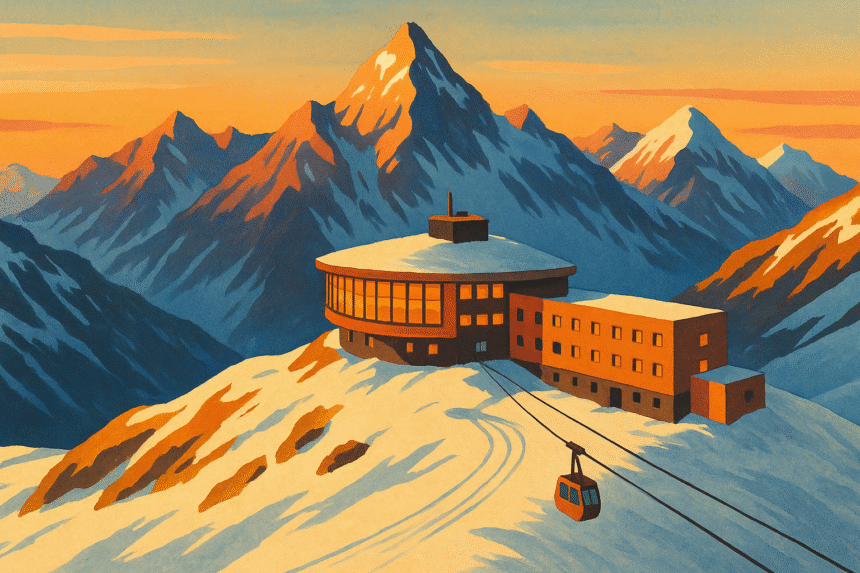Perched 3,212 metres above sea level, the Glacier Hotel Grawand in Italy’s Val Senales is Europe’s highest hotel — a remote yet remarkable retreat where reaching the lobby is an adventure in itself. Accessible only by cable car, guests ascend 1,200 vertical metres along a steep cliff, crossing into a world of snow, silence, and sweeping Alpine panoramas that stretch to the Austrian border.
A Hotel Above the Clouds
Located just below the summit of Mount Grawand, the hotel sits at the edge of the Hochjoch glacier, offering an unmatched view of the icy landscape below. Unlike the minimalist mountain refuges scattered across the Alps, the Glacier Grawand combines altitude with comfort. Its 36 double rooms each open to breathtaking mountain vistas, while guests can unwind in a sauna, cocktail bar, gym, and panoramic restaurant — a rare blend of rugged isolation and Alpine luxury.
At 300 metres higher than the Pic du Midi Observatory hotel in the Pyrenees and 100 metres above Zermatt’s Kulmhotel Gornergrat, the Glacier Grawand holds a unique record. Yet, despite its elevation, it remains relatively unknown, along with the surrounding Val Senales ski resort. “When we built it, no one realized it was Europe’s highest hotel,” says Armin Mair, the 70-year-old manager, smiling as he recalls its unlikely origins.
From a Farmer’s Dream to an Alpine Landmark
The story of the hotel begins with Leo Gurschler, born in 1947 in the mountain hamlet of Maso Corto (Kurzras). What started as a small ski lift on his family’s farm in the 1960s soon evolved into an ambitious vision: to build a cable car up the Grawand ridge, creating jobs and revitalizing a depopulating valley. Despite skepticism from locals, Gurschler personally drove his excavator up the mountain in 1972 to lay the foundation. By 1975, the cable car was operating, and four years later, the Glacier Grawand opened its doors.
Even today, Val Senales remains modest in size, with 42km of pistes and 11 lifts. However, its high altitude and reliable snow attract professional athletes and Olympic teams for pre-season training. “We hosted Marco Odermatt recently,” Mair says proudly. For recreational skiers, the resort offers a serene, family-friendly escape — especially on weekends, when locals from Merano and Bolzano fill the slopes and the hotel’s restaurant.
Life at the Top of Europe
When the day’s visitors descend, the Glacier Grawand transforms. As the sun sets over the peaks, the bar and circular dining hall glow with the orange hues of Aperol spritzes and twilight reflections. The interiors, refurbished in 2003, still carry a distinct 1970s character — an aesthetic that, combined with the hotel’s airlock doors and geometric structure, gives it a faintly space-age feel. Dinner is a single-course affair served to around 20 overnight guests, featuring regional dishes and fine South Tyrolean wines.
For Mair, managing the hotel is more than a job — it’s a passion. After a long career in publishing and hospitality management, he took over Glacier Grawand after retiring. “They even used to have a swimming pool,” he notes wistfully, though melting permafrost forced its closure when the ground beneath began to shift. Ironically, the same melting glaciers later revealed one of the most significant archaeological discoveries of the modern era — Ötzi the Iceman.
The Legacy of Ötzi the Iceman
In 1991, hikers discovered a perfectly preserved body melting out of the Hochjoch glacier, just a kilometre from the hotel. At first mistaken for a 20th-century climber, carbon dating later confirmed the man was over 5,000 years old. Ötzi — as he became known — was found with his clothing, tools, and internal organs intact, providing scientists with extraordinary insights into Copper Age life.
“We know he was born near here, and lived his final years in Val Senales,” says Andreas Putzer, curator of the South Tyrol Museum of Archaeology in Bolzano, where the mummy now rests. Researchers found traces of local grindstone sand in his intestines and evidence of high-altitude living in his muscles. His medicinal fungi and tattooed acupuncture points suggested an early understanding of medicine. After years of study, scientists concluded that Ötzi was killed on the mountain — shot in the back with an arrow, likely in a personal dispute rather than a robbery.
Where Ancient History Meets Modern Heights
Today, visitors can ski or hike to the spot where Ötzi was found — a windswept ridge offering the same panoramic view he once saw. Standing there, facing the vast, frozen landscape, it’s easy to imagine both the isolation and endurance that define life in these mountains.
As guests return to the Glacier Grawand to warm up over dinner, the contrast between ancient survival and modern comfort becomes striking. Despite the passage of 5,000 years, the pull of the mountains — their beauty, danger, and mystery — remains unchanged.








